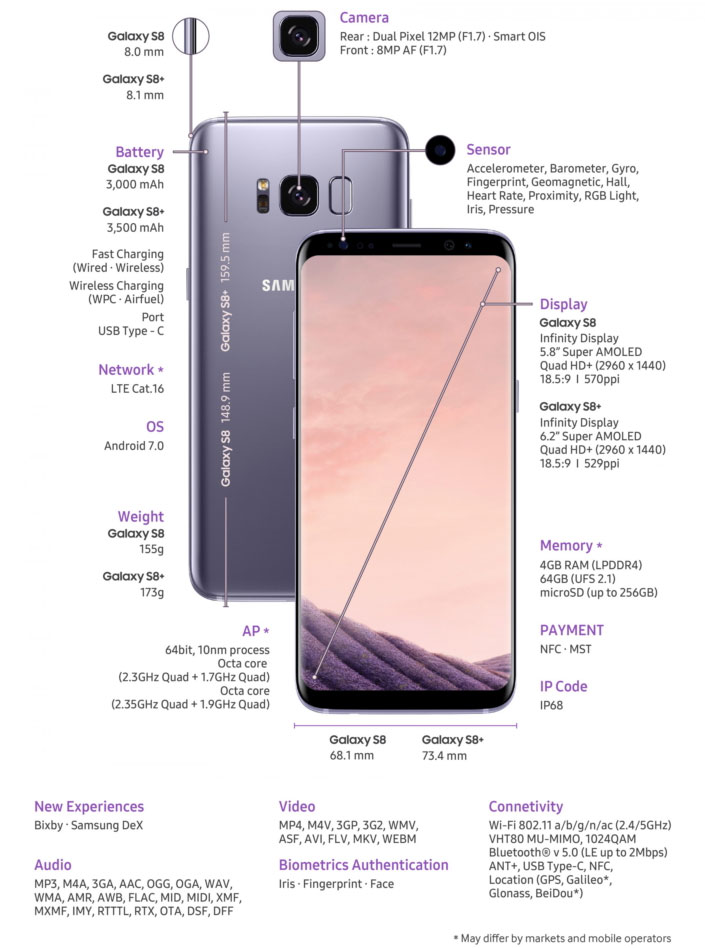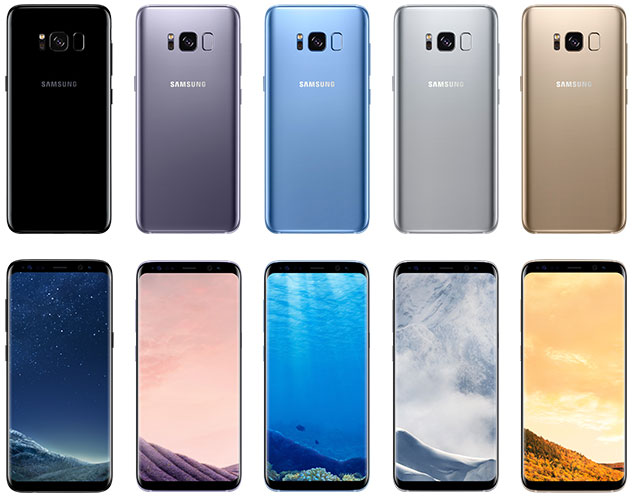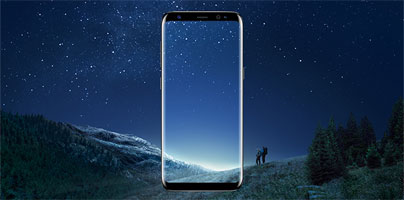On March 29, at the Galaxy UNPACKED 2017 event in New York, Samsung unveiled the brand new Galaxy S8 and S8+, presenting it as "a smartphone that pushes the boundaries of traditional smartphones."
Now that Samsung has officially took the wraps off the Galaxy S8 and Galaxy S8+, I can finally present the most important things you must know about these devices. Here goes!
1. Infinity Display and a "bezel-less" design
The Galaxy S8 had a dual-edge edge display that Samsung dubbed the Infinity Display. The display is protected by Corning Gorilla Glass 5, making it impervious to scratches and external impacts. And since I brought this up, I’m going to add that the Galaxy S8 is impervious to water and dust as well.
Although Samsung says that the Galaxy S8 has a bezel-less design, the bezel isn’t actually gone. But it has been reduced so much that the display takes up more than 80% of the phone’s front screen. With the bezel almost gone and with the screen flowing over the phone’s edge, you can see more and you can have a more immersive viewing experience.
Compared to the previous model, the Galaxy S7, the screen is 18% larger. And while the Galaxy S7 and S7 Edge had a 5.1-inch and a 5.5-inch display respectively, the Galaxy S8 and S8+ have a 5.8-inch and 6.2-inch display.
2. This is what’s "under the hood"
Samsung Galaxy S8 Specs
Samsung Galaxy S8+ Specs
Via Samsung Newsroom.
Compared to the Galaxy S7, the new Galaxy S8 has a better and bigger display, a more powerful front camera, a new 10nm processor, more storage space, LTE Cat.16 instead of LTE Cat.9, and iris and face recognition not just fingerprint recognition. Check out this infographic if you want to see how the Galaxy S8’s specs compare to the Galaxy S7’s.
3. Five colors to choose from
According to Samsung, the Galaxy S8 "will be offered in a rich color palette" that includes these 5 color options: Midnight Black, Orchid Gray, Arctic Silver, Coral Blue and Maple Gold.

"The phone’s metal frames balance nicely with the natural luster and depth of its glass body, creating a seamless color transition that brings together art and technology to complete the phone’s concept of oneness," Samsung explained.
4. Meet Bixby
The Galaxy S8 comes with an "intelligent interface” called Bixby which can execute voice commands and provide useful information at the right time. It can detect what you’re looking at and bring up related information, it provides contextual reminders based on your location and routine, and it displays most contextually relevant apps and services on a single screen.
"With the continued investment from Samsung on artificial intelligence, the possibility of what Bixby can become is endless," said InJong Rhee, Executive Vice President, Head of R&D, Software and Services.
Check out this video interview with InJong Rhee if you want to learn more about Bixby and how it provides a more personalized experience and enhances the way people interact with their phones and the world around them.
5. Samsung DeX turns your mobile into a desktop
Remember Microsoft’s Continuum, the Windows 10 feature that let you connect your mobile to a monitor, keyboard and mouse and thus turn your phone into a desktop? Well, Samsung DeX is similar to Microsoft’s Continuum, allowing you to turn your Android-powered Galaxy S8 into a desktop computer.
You will need a few extras though. First and foremost, you’ll need the Dex Station that connects the smartphone to an HDMI compatible monitor. On top of that, you will need a Bluetooth-enabled, USB or RF-type keyboard and mouse.
The DeX Station features two USB 2.0 ports, USB Type-C power-in, Ethernet, and Adaptive Fast Charging (AFC) technology to charge your Samsung smartphone quickly while connected.
"The smartphone has become the central point for the modern mobile professional, and when giving a presentation or editing documents remotely, it means they can work effectively using just their smartphone. We developed Samsung DeX with the highly mobile worker in mind, giving them a convenient and flexible desktop experience," said Injong Rhee, CTO of the Mobile Communications Business at Samsung Electronics.
"Our collaboration with key partners such as Adobe and Microsoft was essential in the development of Samsung DeX, as they share our vision for building excellence in mobile productivity. With Samsung DeX, enterprise users can also be assured their smartphone and data are protected by the Samsung Knox security platform built into the smartphone. Samsung DeX redefines what a smartphone can do to keep mobile professionals productive."
6. Three biometric authentication options
The Galaxy S8 features three biometric authentication options: fingerprint scanner, iris scanner and new facial recognition capabilities.
If you don't want to use biometrics to protect your device, you can always lock it with a PIN, password or pattern.
7. Release date and price
The Galaxy S8 and S8+ will be released to the public on April 21st, 2017.
Pricing for the Galaxy S8 is around $750 and pricing for the Galaxy S8+ is around $850.
"The Samsung Galaxy S8 and S8+ usher in a new era of smartphone design and fantastic new services, opening up new ways to experience the world," said DJ Koh, President of Mobile Communications Business, Samsung Electronics. "The Galaxy S8 and S8+ are our testament to regaining your trust by redefining what’s possible in safety and marks a new milestone in Samsung’s smartphone legacy."
Now that Samsung has officially took the wraps off the Galaxy S8 and Galaxy S8+, I can finally present the most important things you must know about these devices. Here goes!
1. Infinity Display and a "bezel-less" design
The Galaxy S8 had a dual-edge edge display that Samsung dubbed the Infinity Display. The display is protected by Corning Gorilla Glass 5, making it impervious to scratches and external impacts. And since I brought this up, I’m going to add that the Galaxy S8 is impervious to water and dust as well.
Although Samsung says that the Galaxy S8 has a bezel-less design, the bezel isn’t actually gone. But it has been reduced so much that the display takes up more than 80% of the phone’s front screen. With the bezel almost gone and with the screen flowing over the phone’s edge, you can see more and you can have a more immersive viewing experience.
Compared to the previous model, the Galaxy S7, the screen is 18% larger. And while the Galaxy S7 and S7 Edge had a 5.1-inch and a 5.5-inch display respectively, the Galaxy S8 and S8+ have a 5.8-inch and 6.2-inch display.
2. This is what’s "under the hood"
Samsung Galaxy S8 Specs
- Operating system – Android 7.0 Nougat
- Display – 5.8-inch Super AMOLED display, Quad HD+ (2960x1440), 570 ppi.
- Dimensions & weight –148.9 x 68.1 x 8.0 mm; 155g.
- Processor – Octa-core (2.3GHz Quad + 1.7GHz Quad), 64 bit, 10 nm processor; Octa-core (2.35GHz Quad + 1.9GHz Quad), 64 bit, 10 nm processor.
- Memory & storage – 4GB of RAM (LPDDR4), 64GB of storage with the option to add a microSD up to 256GB.
- Camera – 8MP front camera, 12MP dual pixel rear camera.
- Connectivity – Wi-Fi, Bluetooth, USB Type-C, NFC, GPS
- Sensors – Accelerometer, Barometer, Fingerprint Sensor, Gyro Sensor, Geomagnetic Sensor, Hall Sensor, Heart Rate Sensor, Proximity Sensor, RGB Light Sensor, Iris Sensor, Pressure Sensor
- Battery – 3,000mAH battery with fast charging on wired and wireless.
Samsung Galaxy S8+ Specs
- Operating system – Android 7.0 Nougat
- Display – 6.2-inch Super AMOLED display, Quad HD+ (2960x1440), 529 ppi.
- Dimensions & weight – 159.5 x 73.4 x 8.1 mm; 173g.
- Processor – Octa-core (2.3GHz Quad + 1.7GHz Quad), 64 bit, 10 nm processor; Octa-core (2.35GHz Quad + 1.9GHz Quad), 64 bit, 10 nm processor.
- Memory & storage – 4GB of RAM (LPDDR4), 64GB of storage with the option to add a microSD up to 256GB.
- Camera – 8MP front camera, 12MP dual pixel rear camera.
- Connectivity – Wi-Fi, Bluetooth, USB Type-C, NFC, GPS
- Sensors – Accelerometer, Barometer, Fingerprint Sensor, Gyro Sensor, Geomagnetic Sensor, Hall Sensor, Heart Rate Sensor, Proximity Sensor, RGB Light Sensor, Iris Sensor, Pressure Sensor
- Battery – 3,500mAH battery with fast charging on wired and wireless.

Via Samsung Newsroom.
Compared to the Galaxy S7, the new Galaxy S8 has a better and bigger display, a more powerful front camera, a new 10nm processor, more storage space, LTE Cat.16 instead of LTE Cat.9, and iris and face recognition not just fingerprint recognition. Check out this infographic if you want to see how the Galaxy S8’s specs compare to the Galaxy S7’s.
3. Five colors to choose from
According to Samsung, the Galaxy S8 "will be offered in a rich color palette" that includes these 5 color options: Midnight Black, Orchid Gray, Arctic Silver, Coral Blue and Maple Gold.

"The phone’s metal frames balance nicely with the natural luster and depth of its glass body, creating a seamless color transition that brings together art and technology to complete the phone’s concept of oneness," Samsung explained.
4. Meet Bixby
The Galaxy S8 comes with an "intelligent interface” called Bixby which can execute voice commands and provide useful information at the right time. It can detect what you’re looking at and bring up related information, it provides contextual reminders based on your location and routine, and it displays most contextually relevant apps and services on a single screen.
"With the continued investment from Samsung on artificial intelligence, the possibility of what Bixby can become is endless," said InJong Rhee, Executive Vice President, Head of R&D, Software and Services.
Check out this video interview with InJong Rhee if you want to learn more about Bixby and how it provides a more personalized experience and enhances the way people interact with their phones and the world around them.
5. Samsung DeX turns your mobile into a desktop
Remember Microsoft’s Continuum, the Windows 10 feature that let you connect your mobile to a monitor, keyboard and mouse and thus turn your phone into a desktop? Well, Samsung DeX is similar to Microsoft’s Continuum, allowing you to turn your Android-powered Galaxy S8 into a desktop computer.
You will need a few extras though. First and foremost, you’ll need the Dex Station that connects the smartphone to an HDMI compatible monitor. On top of that, you will need a Bluetooth-enabled, USB or RF-type keyboard and mouse.
The DeX Station features two USB 2.0 ports, USB Type-C power-in, Ethernet, and Adaptive Fast Charging (AFC) technology to charge your Samsung smartphone quickly while connected.
"The smartphone has become the central point for the modern mobile professional, and when giving a presentation or editing documents remotely, it means they can work effectively using just their smartphone. We developed Samsung DeX with the highly mobile worker in mind, giving them a convenient and flexible desktop experience," said Injong Rhee, CTO of the Mobile Communications Business at Samsung Electronics.
"Our collaboration with key partners such as Adobe and Microsoft was essential in the development of Samsung DeX, as they share our vision for building excellence in mobile productivity. With Samsung DeX, enterprise users can also be assured their smartphone and data are protected by the Samsung Knox security platform built into the smartphone. Samsung DeX redefines what a smartphone can do to keep mobile professionals productive."
6. Three biometric authentication options
The Galaxy S8 features three biometric authentication options: fingerprint scanner, iris scanner and new facial recognition capabilities.
If you don't want to use biometrics to protect your device, you can always lock it with a PIN, password or pattern.
7. Release date and price
The Galaxy S8 and S8+ will be released to the public on April 21st, 2017.
Pricing for the Galaxy S8 is around $750 and pricing for the Galaxy S8+ is around $850.
"The Samsung Galaxy S8 and S8+ usher in a new era of smartphone design and fantastic new services, opening up new ways to experience the world," said DJ Koh, President of Mobile Communications Business, Samsung Electronics. "The Galaxy S8 and S8+ are our testament to regaining your trust by redefining what’s possible in safety and marks a new milestone in Samsung’s smartphone legacy."

























